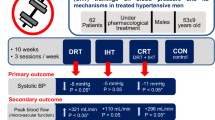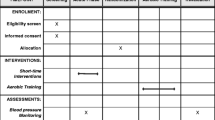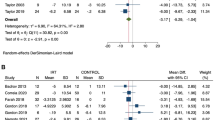Abstract
Purpose of Review
To elucidate the hemodynamic, autonomic, vascular, hormonal, and local mechanisms involved in the blood pressure (BP)–lowering effect of dynamic resistance training (DRT) in prehypertensive and hypertensive populations.
Recent Findings
The systematic search identified 16 studies involving 17 experimental groups that assessed the DRT effects on BP mechanisms in prehypertensive and/or hypertensive populations. These studies mainly enrolled women and middle-aged/older individuals. Vascular effects of DRT were consistently reported, with vascular conductance, flow-mediated dilation, and vasodilatory capacity increases found in all studies. On the other hand, evidence regarding the effects of DRT on systemic hemodynamics, autonomic regulation, hormones, and vasoactive substances are still scarce and controversial, not allowing for any conclusion.
Summary
The current literature synthesis shows that DRT may promote vascular adaptations, improving vascular conductance and endothelial function, which may have a role in the BP-lowering effect of this type of training in prehypertensive and hypertensive individuals. More studies are needed to explore the role of other mechanisms in the BP-lowering effect of DRT.



Similar content being viewed by others
References
Papers of particular interest, published recently, have been highlighted as: • Of importance •• Of major importance
Lawes CM, Hoorn S, Vander RA. Global burden of blood-pressure-related disease, 2001. Lancet. 2008;371:1513–8.
Beevers G, Lip GY, O’Brien E. The pathophysiology of hypertension. BMJ. 2001;322:912–6.
•• Whelton PK, Carey RM, Aronow WS, Ovbiagele B, Casey DE, Smith SC, et al. 2017 ACC / AHA / AAPA / ABC / ACPM / AGS / APhA / ASH / ASPC / NMA / PCNA Guideline for the prevention, detection, evaluation, and management of high blood pressure in adults. A report of the American College of Cardiology/American Heart Association T. Hypertension. 2018;71:1269–324. This important guideline for hypertension management was the first to establish dynamic resistance training as one of the best proven nonpharmacological interventions.
Dorans KS, Mills KT, Liu Y, He J. Trends in prevalence and control of hypertension according to the 2017 American College of Cardiology/American Heart Association (ACC/AHA) guideline. J Am Heart Assoc. 2018;7:e008888.
Williams B, Mancia G, Spiering W, Rosei E, Azizi M, Burnier M. 2018 ESC/ESH Guidelines for the management of arterial hypertension. J Hypertens. 2018;36:1953–2041.
Malachias M, Souza W, Plavnik F, Rodrigues C, Sociedade Brasileira de Cardiologia. 7a Diretriz Brasileira de Hipertensão Arterial. Arq Bras Cardiol. 2016;107:1–83 Available from: www.arquivosonline.com.br.
Kraemer WJ, Ratamess NA, Flanagan SD, Shurley JP, Todd JS, Todd TC. Understanding the science of resistance training: an evolutionary perspective. Sport Med Springer International Publishing. 2017;47:2415–35.
•• MacDonald HV, Johnson BT, Huedo-Medina TB, Livingston J, Forsyth KC, Kraemer WJ, et al. Dynamic resistance training as stand-alone antihypertensive lifestyle therapy: a meta-analysis. J Am Heart Assoc. 2016;5:e003231 This is a comprehensive meta-analysis attending high-quality standards that proposed dynamic resistance training as a viable stand-alone therapeutic exercise option.
Fagard RH, Cornelissen VA. Effect of exercise on blood pressure control in hypertensive patients. Eur J Cardiovasc Prev Rehabil. 2007;14:12–7.
Tomeleri CM, Marcori AJ, Ribeiro AS, Gerage AM, Padilha CDS, Schiavoni D, et al. Chronic blood pressure reductions and increments in plasma nitric oxide bioavailability. Int J Sports Med. 2017;38:290–9.
Trevizani GA, Seixas MB, Benchimol-Barbosa PR, Vianna JM, Pinto da Silva L, Nadal J. Effect of resistance training on blood pressure and autonomic responses in treated hypertensives. J Strength Cond Res. 2018;32:1462–70.
Cononie C, Graves J, Pollock M, Phillips I, Sumners C, Hagberg J. Effect of exercise training on blood pressure in 70- to 79-yr-old men and women. Med Sci Sports Exerc. 1991;23:505–11.
Collier SR, Kanaley JA, Carhart R, Frechette V, Tobin MM, Bennett N, et al. Cardiac autonomic function and baroreflex changes following 4 weeks of resistance versus aerobic training in individuals with pre-hypertension. Acta Physiol. 2009;195:339–48.
Collier SR, Kanaley JA, Carhart R, Frechette V, Tobin MM, Hall AK, et al. Effect of 4 weeks of aerobic or resistance exercise training on arterial stiffness, blood flow and blood pressure in pre- and stage-1 hypertensives. J Hum Hypertens. 2008;22:678–86.
• Boeno FP, Ramis TR, Munhoz SV, Farinha JB, CEJ M, Leal-Menezes R, et al. Effect of aerobic and resistance exercise training on inflammation, endothelial function and ambulatory blood pressure in middle-aged hypertensive patients. J Hypertens. 2020;38:2501–9 This contemporary randomized controlled trial with hypertensive patients supported dynamic resistance training as a valuable non-pharmacological treatment for these patients by showing that its effects reducing ambulatory blood pressure and improving vascular function are similar to those observed with aerobic training in a head-to-head comparison.
Beck DT, Casey DP, Martin JS, Emerson BD, Braith R. Exercise training improves endothelial function in young prehypertensives. Exp Biol Med. 2013;238:433–41.
Beck DT, Martin JS, Casey DP, Braith RW. Exercise training improves endothelial function in resistance arteries of young prehypertensives. J Hum Hypertens. 2014;28:303–9.
Terra DF, Mota Rabelo M, Thomaz RH, Bezerra LMA, Lima RM, Ribeiro AG, et al. Redução da Pressão Arterial e do Duplo Produto de Repouso após Treinamento Resistido em Idosas Hipertensas. Arq Bras Cardiol. 2008;91:299–305.
• Pedralli M, Marschner R, Kollet D, Neto S, Eibel B, Tanaka H, et al. Different exercise training modalities produce similar endothelial function improvements in individuals with prehypertension or hypertension: a randomized clinical trial exercise, endothelium and blood pressure. Sci Rep. 2020;10:7628 This randomized clinical trial showed that dynamic resistance training promoted reductions on ambulatory systolic blood pressure (24-h period) and increases on flow-mediated dilation of similar magnitudes when compared with aerobic training. Besides that, an intervention that combined aerobic and dynamic resistance training did not show superior effects when compared with both exercise modes performed alone. Thus, its results reinforced the clinical value of dynamic resistance training in the management of pre-hypertension and hypertension.
Stensvold D, Tjønna A, Skaug E. Strength training versus aerobic interval training to modify risk factors of metabolic syndrome. J Appl Physiol. 2010;108:804–10.
Moraes M, Bacurau R. Chronic conventional resistance exercise reduces blood pressure in stage 1 hypertensive men. J Strength Cond Res 2012;0:1–8.
Coelho-Júnior HJ, Gonçalves I d O, NOS C, Cenedeze MA, Bacurau RF, Asano RY, et al. Non-periodized and daily undulating periodized resistance training on blood pressure of older women. Front Physiol. 2018;9:1–13.
De Sá CA, Catani D, Cardoso AM, Da Silva Grigoletto ME, Battiston FG, Corralo VS. Resistance training affects the hemodynamic parameters of hypertensive and normotensive women differently, and regardless of performance improvement. J Exerc Sci Fit. 2020;18:122–8.
Dantas FFO, Brasileiro-Santos M d S, RMF B, do Nascimento LS, LRC C, Ritti-Dias RM, et al. Effect of strength training on oxidative stress and the correlation of the same with forearm vasodilatation and blood pressure of hypertensive elderly women: a randomized clinical trial. PLoS One. 2016;11:1–19.
Oliveira-Dantas FF, do Brasileiro-Santos MS, Thomas SG, Silva AS, Silva DC, RAV B, et al. Short-term resistance training improves cardiac autonomic modulation and blood pressure in hypertensive older women. J Strength Cond Res. 2020;34:37–45.
Chobanian AV, Bakris GL, Black HR, Cushman WC, Green LA, Izzo J Jr, et al. Seventh report of the joint national committee on prevention, detection, evaluation, and treatment of high blood pressure. Hypertension. 2003;42:1206–52.
Sociedade Brasileira de Cardiologia, Sociedade Brasileira de Hipertensão, Sociedade Brasileira de Neufrologia. VI Diretrizes Brasileiras de Hipertensão. Arq Bras Cardiol. 2010;95:1–51.
Alberti KGMM, Zimmet P, Shaw J. Metabolic syndrome - A new world-wide definition. A consensus statement from the International Diabetes Federation. Diabet Med. 2006;23:469–80.
Anton MM, Cortez-Cooper MY, DeVan AE, Neidre DB, Cook JN, Tanaka H. Resistance training increases basal limb blood flow and vascular conductance in aging humans. J Appl Physiol. 2006;101:1351–5.
Kanegusuku H, Queiroz ACC, Silva VJD, De Mello MT, Ugrinowitsch C, Forjaz CLM. High-intensity progressive resistance training increases strength with no change in cardiovascular function and autonomic neural regulation in older adults. J Aging Phys Act. 2015;23:339–45.
Mohrman DE, Heller LJ. Cardiovascular physiology. 9th ed. Medical M-HE/, editor. 2018.
Ashor AW, Lara J, Siervo M, Celis-Morales C, Oggioni C, Jakovljevic DG, et al. Exercise modalities and endothelial function: a systematic review and dose–response meta-analysis of randomized controlled trials. Sports Med. 2015;45:279–96.
Sarelius I, Pohl U. Control of muscle blood flow during exercise: local factors and integrative mechanisms. Acta Physiol. 2010;199:349–65.
Asmussen E. Similarities and dissimilarities between static and dynamic exercise. Circ Res. 1981;48:I3–10.
Tinken TM, Thijssen DHJ, Hopkins N, Dawson EA, Cable NT, Green DJ. Shear stress mediates endothelial adaptations to exercise training in humans. Hypertension. 2010;55:312–8.
Green DJ, Hopman MTE, Padilla J, Laughlin MH, Thijssen DHJ. Vascular adaptation to exercise in humans: role of hemodynamic stimuli. Physiol Rev. 2017;97:495–528.
Spence AL, Carter HH, Naylor LH, Green DJ. A prospective randomized longitudinal study involving 6 months of endurance or resistance exercise. Conduit artery adaptation in humans. J Physiol. 2013;591:1265–75.
Carter JR, Ray CA, Downs EM, Cooke WH. Strength training reduces arterial blood pressure but not sympathetic neural activity in young normotensive subjects. J Appl Physiol. 2003;94:2212–6.
Hanssen H, Boardman H, Deiseroth A, Moholdt T, Simonenko M, Kränkel N, et al. Personalized exercise prescription in the prevention and treatment of arterial hypertension: a consensus document from the European Association of Preventive Cardiology (EAPC) and the ESC Council on Hypertension. Eur J Prev Cardiol. 2021.
Benjamin EJ, Larson MG, Keyes MJ, Mitchell GF, Vasan RS, Keaney JF, et al. Clinical correlates and heritability of flow-mediated dilation in the community: the Framingham Heart Study. Circulation. 2004;109:613–9.
Matsuzawa Y, Kwon TG, Lennon RJ, Lerman LO, Lerman A. Prognostic value of flow-mediated vasodilation in brachial artery and fingertip artery for cardiovascular events: a systematic review and meta-analysis. J Am Heart Assoc. 2015;4:e002270.
Hajjar I, Kotchen TA. Trends in prevalence, awareness, treatment, and control of hypertension in the United States, 1988-2000. J Am Med Assoc. 2003;290:199–206.
Skaug EA, Aspenes ST, Oldervoll L, Mørkedal B, Vatten L, Wisløff U, et al. Age and gender differences of endothelial function in 4739 healthy adults: the HUNT3 fitness study. Eur J Prev Cardiol. 2013;20:531–40.
Availability of Data and Material
Not applicable.
Code Availability
Not applicable.
Funding
This study was supported by the Brazilian National Council for Scientific and Technological Development (CNPQ, process 304436/2018-6), the São Paulo Research Foundation (FAPESP, process 2018/12390-1) and Coordenação de Aperfeiçoamento de Pessoal de Nível Superior (CAPES, process 0001).
Author information
Authors and Affiliations
Corresponding author
Ethics declarations
Conflict of Interest
The authors declare competing interests.
Human and Animal Rights and Informed Consent
This article does not contain any studies with human or animal subjects performed by any of the authors.
Consent to Participate
Not applicable.
Additional information
Publisher’s Note
Springer Nature remains neutral with regard to jurisdictional claims in published maps and institutional affiliations.
This article is part of the Topical Collection on Mechanisms of Hypertension and Target-Organ Damage
Rights and permissions
About this article
Cite this article
Fecchio, R.Y., Brito, L.C., Peçanha, T. et al. Potential Mechanisms Behind the Blood Pressure–Lowering Effect of Dynamic Resistance Training. Curr Hypertens Rep 23, 35 (2021). https://doi.org/10.1007/s11906-021-01154-5
Accepted:
Published:
DOI: https://doi.org/10.1007/s11906-021-01154-5




